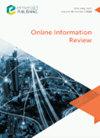Creating a virtuous circle during a pandemic threat: netizens' resilience via information-induced psychological distance and social media approach
IF 3.1
3区 管理学
Q2 COMPUTER SCIENCE, INFORMATION SYSTEMS
引用次数: 0
Abstract
Purpose During COVID-19 restrictions, people spent more time in cyberspace and consuming health-related information. An increase was also observed in mediated caring messages or health-relevant information sent to one another. This study aims to explore how the information and interactions around COVID-19 can provide a good learning opportunity for public health, specifically related to eHealth literacy and eHealth promotion. Design/methodology/approach While mainstream literature has concentrated on experimental designs and a priming effect, this study inspects psychological distance related to a health threat under real-life circumstances. The article adopted a survey approach and utilized PLS-SEM techniques to examine the proposed hypotheses. Findings Results indicated that whereas closer social support correlates with closer psychological distance and less usage of the social media approach, more substantial COVID-19 impacts were associated with closer psychological distance but greater use of social media. Since both closer psychological distance and social media approach contribute to eHealth literacy, social support from closer and virtual social networks should be embraced but utilized through different routes and for different purposes. The timing of messages but not psychological distance affects people's social media approach, indicating that morning messages should be employed. Moreover, eHealth literacy mediates timing preferences and leads to a preference for eHealth communication earlier in the day. Overall, morning messages create a virtuous circle during a health crisis. Originality/value This paper establishes a mechanism of virtuous cycles for eHealth communication during a health threat. Additionally, it bridges existing research gaps by expanding chronopsychology and CLT in the health domain using an empirical approach, a real-life case and an extension of performance regarding information-seeking and utilization.在大流行威胁中创造良性循环:信息诱导的心理距离和社交媒体方法的网民复原力
在COVID-19限制期间,人们花更多时间在网络空间和消费与健康相关的信息。相互发送的中介关怀信息或健康相关信息也有所增加。本研究旨在探讨围绕COVID-19的信息和互动如何为公共卫生提供良好的学习机会,特别是与电子卫生素养和电子卫生促进有关的机会。设计/方法/方法虽然主流文献集中在实验设计和启动效应上,但本研究考察了现实生活中与健康威胁相关的心理距离。本文采用调查方法,并利用PLS-SEM技术来检验提出的假设。研究结果表明,虽然更紧密的社会支持与更近的心理距离和更少的社交媒体使用相关,但更大的COVID-19影响与更近的心理距离和更多的社交媒体使用相关。由于更近的心理距离和社交媒体方法都有助于电子卫生扫盲,因此应该接受来自更近和虚拟社交网络的社会支持,但应通过不同的途径和不同的目的加以利用。消息的时间而不是心理距离影响人们的社交媒体方式,这表明应该使用早晨消息。此外,电子健康素养调节了时间偏好,并导致人们更倾向于在一天的早些时候进行电子健康交流。总的来说,在健康危机期间,晨间短信创造了一个良性循环。本文建立了健康威胁下电子健康沟通的良性循环机制。此外,它通过使用经验方法、现实案例和扩展有关信息寻求和利用的性能,扩大健康领域的时间心理学和CLT,弥合了现有的研究差距。
本文章由计算机程序翻译,如有差异,请以英文原文为准。
求助全文
约1分钟内获得全文
求助全文
来源期刊

Online Information Review
工程技术-计算机:信息系统
CiteScore
6.90
自引率
16.10%
发文量
67
审稿时长
6 months
期刊介绍:
The journal provides a multi-disciplinary forum for scholars from a range of fields, including information studies/iSchools, data studies, internet studies, media and communication studies and information systems.
Publishes research on the social, political and ethical aspects of emergent digital information practices and platforms, and welcomes submissions that draw upon critical and socio-technical perspectives in order to address these developments.
Welcomes empirical, conceptual and methodological contributions on any topics relevant to the broad field of digital information and communication, however we are particularly interested in receiving submissions that address emerging issues around the below topics.
Coverage includes (but is not limited to):
•Online communities, social networking and social media, including online political communication; crowdsourcing; positive computing and wellbeing.
•The social drivers and implications of emerging data practices, including open data; big data; data journeys and flows; and research data management.
•Digital transformations including organisations’ use of information technologies (e.g. Internet of Things and digitisation of user experience) to improve economic and social welfare, health and wellbeing, and protect the environment.
•Developments in digital scholarship and the production and use of scholarly content.
•Online and digital research methods, including their ethical aspects.
 求助内容:
求助内容: 应助结果提醒方式:
应助结果提醒方式:


